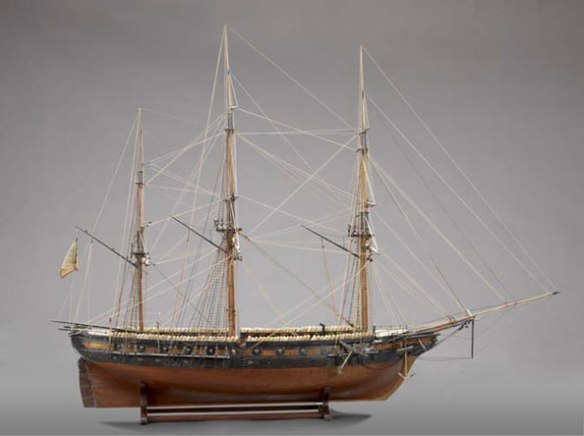
Corvette, French around 1800.
A warship with a flush deck and a single tier of guns. In the days of sailing ships, corvettes were ship-rigged (square-rigged) and smaller and faster than a frigate. Corvettes were frequently propelled by oars as well as sails. In particular, ships of less than 28 guns in the French navy were classified as corvettes. Generally, these ships were intended for scouting, convoy, and privateering service. The British equivalent, called a “sloop,” was sometimes rigged as a brig or schooner.
A prime American example of a corvette was the General Pike, which was launched in 1813. Measuring 174′ from figurehead to stern, she was 37′ wide and carried 26 × long 24-pounders and 2 × 24-pounder carronades. Her main topgallant mast top was 195′ above the deck.
During the Age of Sail, corvettes were one of many types of smaller warships. They were very closely related to sloops-of-war. The role of the corvette consisted mostly of coastal patrol, fighting minor wars, supporting large fleets, or participating in show-the-flag missions. The English Navy began using small ships in the 1650s, but described them as sloops rather than corvettes. The first reference to a corvette was with the French Navy in the 1670s, which may be where the term originated. The Royal Navy did not use the term until after the Napoleonic Wars to describe a small unrated vessel somewhat larger than a sloop.
Most corvettes and sloops of the 17th century were around 40 to 60 feet (12 to 18 m) in length and measured 40 to 70 tons burthen. They carried four to eight smaller guns on a single deck.
Over time, vessels of increasing size and capability were called corvettes; by 1800 they reached lengths of over 100 feet (30 m) and measured from 400 to 600 tons burthen. One of the largest corvettes during the Age of Sail was the American ship USS Constellation, built in 1855; at 176 feet (54 m) long, she carried 24 guns. She was so large that some naval experts consider her a frigate.
Visiting USS Constitution in Dry Dock
USS Constellation constructed in 1854 is a sloop-of-war/corvette and the second United States Navy ship to carry this famous name. According to the US Naval Registry the original frigate was disassembled on 25 June 1853 in Gosport Navy Yard in Norfolk Virginia, and the sloop-of-war was constructed in the same yard, possibly with a few recycled materials from the old frigate. USS Constellation is the last sail-only warship designed and built by the U.S. Navy. Despite being a single-gundeck “sloop”, she is actually larger than her frigate namesake, and more powerfully armed with fewer but much more potent shell-firing guns.
The sloop was launched on 26 August 1854 and commissioned on 28 July 1855 with Captain Charles H. Bell in command.
From 1855-1858 Constellation performed largely diplomatic duties as part of the US Mediterranean Squadron.
She was flagship of the USN African Squadron from 1859-1861. In this period she disrupted the African slave trade by interdicting three slave ships and releasing the imprisoned Africans.
On December 21, 1859, she captured the brig Delicia which was “without colors or papers to show her nationality completely fitted in all respects for the immediate embarcation [sic] of slaves…”
On September 26, 1860, the Constellation captured the “fast little bark” Cora with 705 slaves, who were set free in Monrovia, Liberia.
On May 21, 1861, the Constellation overpowered the slaver brig Triton in African coastal waters. It held no slaves, although “every preparation for their reception had been made.
Constellation spent much of the war as a deterrent to Confederate cruisers and commerce raiders in the Mediterranean Sea
References
Chapelle, Howard I. The History of American Sailing Ships. New York: W. W. Norton, 1935.
King, Dean. A Sea of Words. New York: Henry Holt, 1997.
Landström, Björn. The Ship. Garden City, NY: Doubleday, 1961.
Rogers, John G. Origins of Sea Terms. Boston: Nimrod Press, 1984.